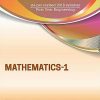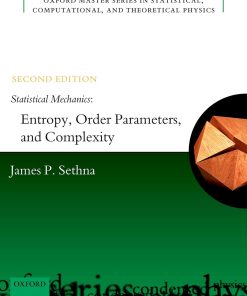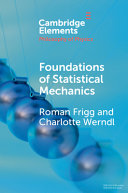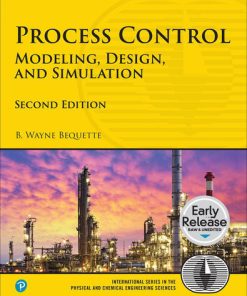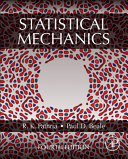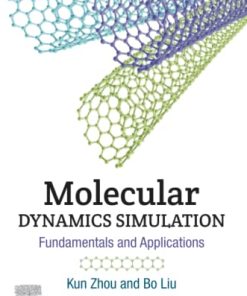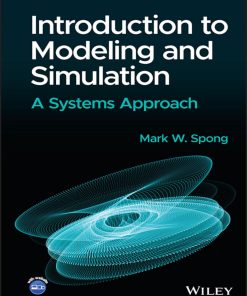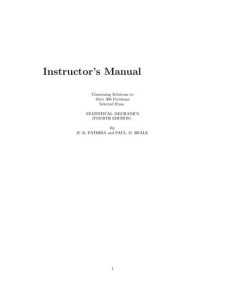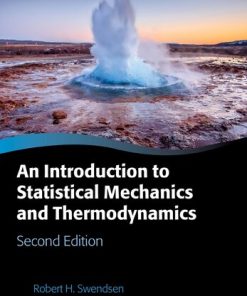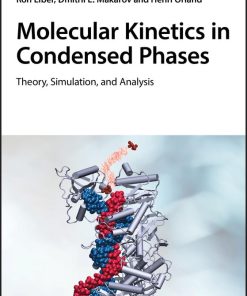(Ebook PDF) Statistical Mechanics Theory and Molecular Simulation 2nd Edition by Mark Tuckerman 0192559613 9780192559616 full chapters
$50.00 Original price was: $50.00.$25.00Current price is: $25.00.
Statistical Mechanics: Theory and Molecular Simulation 2nd Edition by Mark E. Tuckerman – Ebook PDF Instant Download/DeliveryISBN: 0192559613, 9780192559616
Full download Statistical Mechanics: Theory and Molecular Simulation 2nd Edition after payment.
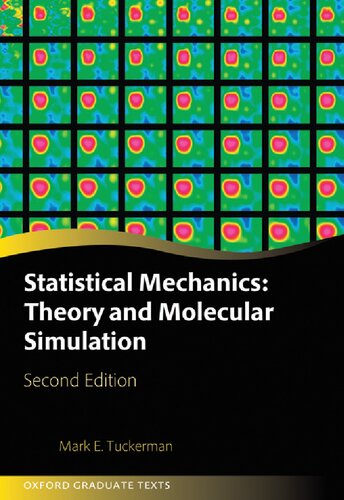
Product details:
ISBN-10 : 0192559613
ISBN-13 : 9780192559616
Author: Mark Tuckerman
Scientists are increasingly finding themselves engaged in research problems that cross the traditional disciplinary lines of physics, chemistry, biology, materials science, and engineering. Because of its broad scope, statistical mechanics is an essential tool for students and more experienced researchers planning to become active in such an interdisciplinary research environment. Powerful computational methods that are based in statistical mechanics allow complex systems to be studied at an unprecedented level of detail. This book synthesizes the underlying theory of statistical mechanics with the computational techniques and algorithms used to solve real-world problems and provides readers with a solid foundation in topics that reflect the modern landscape of statistical mechanics. Topics covered include detailed reviews of classical and quantum mechanics, in-depth discussions of the equilibrium ensembles and the use of molecular dynamics and Monte Carlo to sample classical and quantum ensemble distributions, Feynman path integrals, classical and quantum linear-response theory, nonequilibrium molecular dynamics, the Langevin and generalized Langevin equations, critical phenomena, techniques for free energy calculations, machine learning models, and the use of these models in statistical mechanics applications. The book is structured such that the theoretical underpinnings of each topic are covered side by side with computational methods used for practical implementation of the theoretical concepts.
Statistical Mechanics: Theory and Molecular Simulation 2nd Table of contents:
1 Classical mechanics
1.1 Introduction
1.2 Newton’s laws of motion
1.3 Phase space: visualizing classical motion
1.4 Lagrangian formulation of classical mechanics: A general framework for Newton’s laws
1.5 Legendre transforms
1.6 Generalized momenta and the Hamiltonian formulation of classical mechanics
1.7 A simple classical polymer model
1.8 The action integral
1.9 Lagrangian mechanics and systems with constraints
1.10 Gauss’s principle of least constraint
1.11 Rigid body motion: Euler angles and quaternions
1.12 Non-Hamiltonian systems
1.13 Problems
2 Theoretical foundations of classical statistical mechanics
2.1 Overview
2.2 The laws of thermodynamics
2.3 The ensemble concept
2.4 Phase-space volumes and Liouville’s theorem
2.5 The ensemble distribution function and the Liouville equation
2.6 Equilibrium solutions of the Liouville equation
2.7 Problems
3 The microcanonical ensemble and introduction to molecular dynamics
3.1 Brief overview
3.2 Basic thermodynamics, Boltzmann’s relation, and the partition function of the microcanonical e
3.3 The classical virial theorem
3.4 Conditions for thermal equilibrium
3.5 The free particle and the ideal gas
3.6 The harmonic oscillator and harmonic baths
3.7 Introduction to molecular dynamics
3.8 Integrating the equations of motion: Finite difference methods
3.9 Systems subject to holonomic constraints
3.10 The classical time evolution operator and numerical integrators
3.11 Multiple time-scale integration
3.12 Symplectic integration for quaternions
3.13 Exactly conserved time-step dependent Hamiltonians
3.14 Illustrative examples of molecular dynamics calculations
3.15 Problems
4 The canonical ensemble
4.1 Introduction: A different set of experimental conditions
4.2 Thermodynamics of the canonical ensemble
4.3 The canonical phase-space distribution and partition function
4.4 Canonical ensemble via entropy maximization
4.5 Energy fluctuations in the canonical ensemble
4.6 Simple examples in the canonical ensemble
4.7 Structure and thermodynamics in real gases and liquids from spatial distribution functions
4.8 Perturbation theory and the van der Waals equation
4.9 Molecular dynamics in the canonical ensemble: Hamiltonian formulation in an extended phase space
4.10 Classical non-Hamiltonian statistical mechanics
4.11 Nos´e-Hoover chains
4.12 Integrating the Nos´e-Hoover chain equations
4.13 The isokinetic ensemble: A variant of the canonical ensemble
4.14 Isokinetic Nos´e-Hoover chains: Achieving very large time steps
4.15 Applying canonical molecular dynamics: Liquid structure
4.16 Problems
5 The isobaric ensembles
5.1 Why constant pressure?
5.2 Thermodynamics of isobaric ensembles
5.3 Isobaric phase-space distributions and partition functions
5.4 Isothermal-isobaric ensemble via entropy maximization
5.5 Pressure and work virial theorems
5.6 An ideal gas in the isothermal-isobaric ensemble
5.7 Extending the isothermal-isobaric ensemble: Anisotropic cell fluctuations
5.8 Derivation of the pressure tensor estimator from the canonical partition function
5.9 Molecular dynamics in the isoenthalpic-isobaric ensemble
5.10 Molecular dynamics in the isothermal-isobaric ensemble I: Isotropic volume fluctuations
5.11 Molecular dynamics in the isothermal-isobaric ensemble II: Anisotropic cell fluctuations
5.12 Atomic and molecular virials
5.13 Integrating the Martyna-Tobias-Klein equations of motion
5.14 The isothermal-isobaric ensemble with constraints: The ROLL algorithm
5.15 Problems
6 The grand canonical ensemble
6.1 Introduction: The need for yet another ensemble
6.2 Euler’s theorem
6.3 Thermodynamics of the grand canonical ensemble
6.4 Grand canonical phase space and the partition function
6.5 Grand canonical ensemble via entropy maximization
6.6 Illustration of the grand canonical ensemble: The ideal gas
6.7 Particle number fluctuations in the grand canonical ensemble
6.8 Potential distribution theorem
6.9 Molecular dynamics in the grand canonical ensemble
6.10 Problems
7 Monte Carlo
7.1 Introduction to the Monte Carlo method
7.2 The Central Limit theorem
7.3 Sampling distributions
7.4 Hybrid Monte Carlo
7.5 Replica exchange Monte Carlo
7.6 Wang-Landau sampling
7.7 Transition path sampling and the transition path ensemble
7.8 Problems
8 Free-energy calculations
8.1 Free-energy perturbation theory
8.2 Adiabatic switching and thermodynamic integration
8.3 Adiabatic free-energy dynamics
8.4 Jarzynski’s equality and nonequilibrium methods
8.5 The problem of rare events
8.6 Collective variables
8.7 The blue moon ensemble approach
8.8 Umbrella sampling and weighted histogram methods
8.9 Wang-Landau sampling
8.10 Driven adiabatic free-energy dynamics
8.11 Metadynamics
8.12 The committor distribution and the histogram test
8.13 Problems
9 Quantum mechanics
9.1 Introduction: Waves and particles
9.2 Review of the fundamental postulates of quantum mechanics
9.3 Simple examples
9.4 Identical particles in quantum mechanics: Spin statistics
9.5 Problems
10 Quantum ensembles and the density matrix
10.1 The difficulty of many-body quantum mechanics
10.2 The ensemble density matrix
10.3 Time evolution of the density matrix
10.4 Quantum equilibrium ensembles
10.5 Problems
11 Quantum ideal gases: Fermi-Dirac and Bose-Einstein statistics
11.1 Complexity without interactions
11.2 General formulation of the quantum-mechanical ideal gas
11.3 An ideal gas of distinguishable quantum particles
11.4 General formulation for fermions and bosons
11.5 The ideal fermion gas
11.6 The ideal boson gas
11.7 Problems
12 The Feynman path integral
12.1 Quantum mechanics as a sum over paths
12.2 Derivation of path integrals for the canonical density matrix and the time evolution operator
12.3 Thermodynamics and expectation values from path integrals
12.4 The continuous limit: Functional integrals
12.5 How to think about imaginary time propagation
12.6 Many-body path integrals
12.7 Quantum free-energy profiles
12.8 Numerical evaluation of path integrals
12.9 Problems
13 Classical time-dependent statistical mechanics
13.1 Ensembles of driven systems
13.2 Driven systems and linear response theory
13.3 Applying linear response theory: Green-Kubo relations for transport coefficients
13.4 Calculating time correlation functions from molecular dynamics
13.5 The nonequilibrium molecular dynamics approach
13.6 Problems
14 Quantum time-dependent statistical mechanics
14.1 Time-dependent systems in quantum mechanics
14.2 Time-dependent perturbation theory in quantum mechanics
14.3 Time correlation functions and frequency spectra
14.4 Examples of frequency spectra
14.5 Quantum linear response theory
14.6 Approximations to quantum time correlation functions
14.7 Problems
15 The Langevin and generalized Langevin equations
15.1 The general model of a system plus a bath
15.2 Derivation of the generalized Langevin equation
15.3 Analytically solvable examples
15.4 Vibrational dephasing and energy relaxation in simple fluids
15.5 Molecular dynamics with the Langevin equation
15.6 Designing memory kernels for specific tasks
15.7 Sampling stochastic transition paths
15.8 Mori-Zwanzig theory
15.9 Problems
16 Discrete models and critical phenomena
16.1 Phase transitions and critical points
16.2 The critical exponents α, β, γ, and δ
16.3 Magnetic systems and the Ising model
16.4 Universality classes
16.5 Mean-field theory
16.6 Ising model in one dimension
16.7 Ising model in two dimensions
16.8 Spin correlations and their critical exponents
16.9 Introduction to the renormalization group
16.10 Fixed points of the renormalization group equations in greater than one dimension
16.11 General linearized renormalization group theory
16.12 Understanding universality from the linearized renormalization group theory
16.13 Other uses of discrete models
16.14 Problems
17 Introduction to machine learning in statistical mechanics
17.1 Machine learning in statistical mechanics: What and why?
17.2 Three key probability distributions
17.3 Simple linear regression as a case study
17.4 Kernel methods
17.5 Neural networks
17.6 Weighted neighbor methods
17.7 Demonstrating machine learning in free-energy simulations
17.8 Clustering algorithms
17.9 Intrinsic dimension of a data manifold
17.10 Problems
People also search for Statistical Mechanics: Theory and Molecular Simulation 2nd:
statistical mechanics theory and molecular simulation pdf
statistical mechanics simulation
statistical mechanics and thermodynamics
statistical mechanics mit
tuckerman statistical mechanics theory and molecular simulation
Tags:
Statistical Mechanics,Theory,Molecular Simulation,Mark Tuckerman
You may also like…
Physics - Mechanics
Statistical Mechanics: Entropy, Order Parameters, and Complexity 2nd Edition
Physics - Thermodynamics
Physics - Mechanics
Physics - Others
Engineering - Engineering - General & Miscellaneous
Introduction to Modeling and Simulation 1st edition by Mark Spong 1119982906 9781119982906
Physics - Mechanics
Statistical Mechanics: Fourth Edition. Instructor’s Manual R.K. Pathria
Biology and other natural sciences
Molecular kinetics in condensed phases: theory, simulation, and analysis First Edition Elber


